#Facial Reconstruction
Text
So, I saw this image on Facebook, and it was supposedly showing what Queen Nefertiti would have looked like in real life:

Now, I thought this AI generated garbage was just truly terrible on a number of levels; first off, she looks wayyyyyy too modern - her makeup is very “Hollywood glamour”, she looks airbrushed and de-aged, and as far as I’m aware, Ancient Egyptians didn’t have mascara, glitter-based eyeshadows and lip gloss. Secondly, her features are exceptionally whitewashed in every sense - this is pretty standard for AI as racial bias is prevalent in feeding AI algorithms, but I genuinely thought a depiction of such a known individual would not exhibit such euro-centric features. Thirdly, the outfit was massively desaturated and didn’t take pigment loss into consideration, and while I *do* like the look of the neck attire, it's not at all accurate (plus, again, AI confusion on the detailing is evident).
So, this inspired me to alter the image on the left to be more accurate based off the sculpture’s features. I looked into Ancient Egyptian makeup and looked at references for kohl eyeliner and clay-based facial pigment (rouge was used on cheeks, charcoal-based powder/paste was used to darken and elongate eyebrows), and I looked at pre-existing images of Nefertiti, both her mummy and other reconstructions. While doing this, I found photos of a 3D scanned sculpture made by scientists at the University of Bristol and chose to collage the neck jewellery over the painting (and edited the lighting and shadows as best as I could).

Something I see a lot of in facial recreations of mummies is maintaining the elongated and skinny facial features as seen on preserved bodies - however, fat, muscle and cartilage shrink/disappear post mortem, regardless of preservation quality; Queen Nefertiti had art created of her in life, and these pieces are invaluable to developing an accurate portrayal of her, whether stylistic or realistic in nature.

And hey, while I don't think my adjustments are perfect (especially the neck area), I *do* believe it is a huge improvement to the original image I chose to work on top of.
I really liked working on this project for the last few days, and I think I may continue to work on it further to perfect it. But, until then, I hope you enjoy!
Remember, likes don't help artists but reblogs do!
#Nefertiti#Queen Nefertiti#Ancient Egypt#Facial Reconstruction#art#artist#digital artist#historical#history#historical figure#ancient egyptians#artistic interpretation#historial facial reconstruction#Neferneferuaten#Queen Neferneferuaten Nefertiti#illustration#digital art#digital illustration
4K notes
·
View notes
Text
Benny had been a brilliant theorist, a college professor; now he was little more than a semi-human, semi-simian. He had been handsome, the machine had ruined that. He had been lucid, the machine had driven him mad.(...)


Tried to draw pre-AM Benny with the little facial reconstruction knowledge I have. It's nowhere near perfect, let alone accurate, but I wanted to try to do him justice.
#art#my art#digital art#artists on tumblr#illustration#benny ihnmaims#i have no mouth and i must scream#ihmaims#facial reconstruction#ted ihnmaims#ellen ihnmaims#gorrister ihnmaims#nimdok ihnmaims#am ihnmaims#allied mastercomputer
593 notes
·
View notes
Text

John Shaw Torrington🩵 An attempt at a facial reconstruction.. I did this in 2020 and for some reason was very hesitant/shy(??) about posting it. To be fair, not much “reconstruction” was necessary since he was in remarkable shape at the time of his exhumation (and I assume he still looks fabulous thanks to that good ol’ permafrost treatment🧊).
Now some thoughts… because I’ve never articulated this online before..💭
I’ve had a fixation on him since I was 14 (I’m 29 now) and have attempted many times over the years to draw him in a more…well, alive state..
and I’ll just say it straight up; I think he has a beautiful, ethereal face. I’ve always thought that, even when I was a kid. If he looks that way in death, I can only imagine what that beauty was like when he was among the living. I tried to capture that in this drawing..
Anyway.. I could ramble on…
This, I think, is the most presentable drawing out of all the attempts I’ve done in the 15 years I’ve ‘known’ him— though it certainly won’t be the last. 🩵
I’m planning on doing similar portraits of Hartnell and Braine… I expect Braine will be difficult because he was not in good shape compared to the other Beechey boys..

** I’m overwhelmed by the positive responses this piece got! Tysm everyone!🥲🙏 It really makes me so happy to see JT get so much love— and I’m sure it warms his heart as well 🩵
#drawing#John Shaw Torrington#digital art#john torrington#beechey island boys#beechey boys#franklin expedition#Victorian#history#arctic exploration#northwest passage#sacred to the memory#the franklin expedition#john geiger#Owen beattie#frozen in time#buried in ice#mummy#ice mummy#facial reconstruction#portrait#my draws#artwork#painting#digital painting#digital drawing#art#my art#the terror#the terror amc
202 notes
·
View notes
Text


'The Winterton Lady' Romano-British Burial and Facial Reconstruction, North Lincolnshire Museum, Scunthorpe
#prehistory#prehistoric#Romano-British#burial#facial reconstruction#archaeology#ancient history#ancient living#ancient cultures#sarcophagus#Lincolnshire#relic#skeleton
56 notes
·
View notes
Text

Facial reconstruction of the Ptolemaic Egyptian Queen Cleopatra VII (r. 51-30 BCE). This artistic representation of Cleopatra is primarily based on a bust from the Berlin Altes Museum, widely agreed to depict Cleopatra. In addition to the Berlin portrait, the features in this reconstruction are based upon contemporary coin portraits and a bust from the British Museum which may depict Cleopatra.
#cleopatra#cleopatra vii#history#ancient egypt#egypt#ptolemaic egypt#ptolemies#ptolemaic dynasty#ancient history#facial reconstruction
137 notes
·
View notes
Text
So apparently Swedish and Polish facial reconstructionists decided to try to recreate the famous Incan "Ice Maiden" mummy dubbed "Juanita".


Truthfully, I feel like these European reconstructionists ( do not know how to re-create Andean facial features and the results ended up... terribly uncanny. So down below, with the use of photoshop, I edited the bust with more Andean Indigenous Peruvian facial features to honor the "Ice Maiden".
My version:
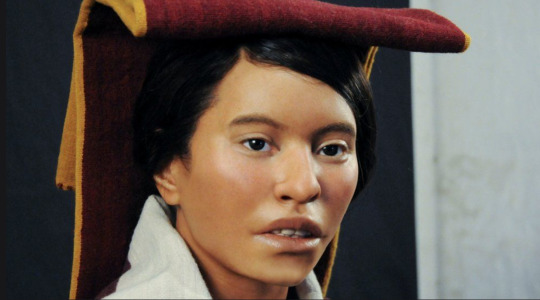
I made her brows straighter and longer, got rid of the cleft chin, gave her a down-turned mouth, broader lips (not small), I made her lips a little larger too and I made her nose longer/bigger and wider around the nasal Ala. I also broadened her nostrils a tad
and I made her under-eyes more puffy
I widened her bone structure
I emphasized her sideburns
My version (on top):
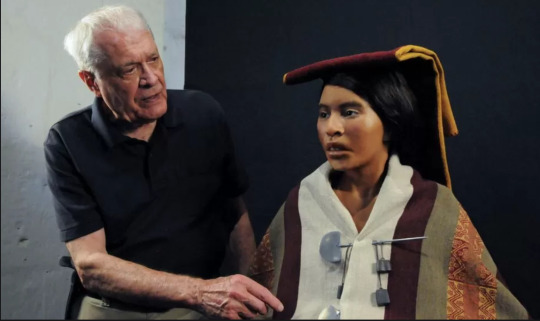
original (white euros created) below:
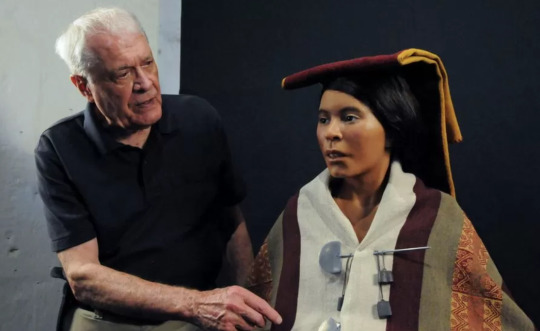
I hope that in the future, more Andean/Indigenous Peruvian facial reconstructionists have opportunities to work on revealing the faces of their kin and ancestors. We needed more andean people involved in her reconstruction.
Let me know what you think of my edits down below too!
I hope you enjoy them!
the original article can be read here:
#I took the artistic liberty to remove her cleft chin all together because i never see andeans like myself with clefts#i love a more down turned lip/mouth shape#archaeology#indigenous peruvians#native peruvian#inca#inca girl#ice maiden#facial reconstruction#my photoshops#andean history#andean pride#native south american#mujer andina#ndn tumblr#andean culture#andean textiles#andean indigenous#indigenous women#andina#andean#bipoc#indigena#pre columbian#andes#warmi#we need more ndns in science
30 notes
·
View notes
Text
6 notes
·
View notes
Text
Facial reconstruction class for the deceased with missing facial parts!👂

30 notes
·
View notes
Text
18 notes
·
View notes
Text

Facial reconstruction of Joseph Groves Boxhall. By: @jusagi91
#jusagi91#facial reconstruction#joseph boxhall#joseph groves boxhall#titanic#rms titanic#titanic movie#titanic 1912#fourth officer#fourth officer boxhall#realistic#hd#picture#colorized#2024#story#board#britain#uk#ship#face#unsinkable#survivor#digital#digital face#photoshop#artbreeder#remini#tumblr
6 notes
·
View notes
Text

Forensic facial reconstructions of Nicholas II (Skeleton 4), Alexandra Feodorovna (Skeleton 7), Olga Nikolaevna (Skeleton 3), Tatiana Nikolaevna (based on the conclusion that she was Skeleton 5), Anastasia Nikolaevna (based on the conclusion that she was Skeleton 6), Eugene Botkin (Skeleton 2), Anna Demidova (Skeleton 1), and Aloise Trupp (Skeleton 9).
#history#imperial russia#romanovs#olga nikolaevna#tatiana nikolaevna#anastasia nikolaevna#anastasia romanov#otma#romanov sisters#nicholas ii#tsar nicholas ii#alexandra feodorovna#forensics#facial reconstruction#eugene botkin#anna demidova#aloise trupp#romanov#romanov family#russian royalty
6 notes
·
View notes
Text
Wonderful reconstruction.
6 notes
·
View notes
Text

#eleanor of aquitaine#reconstruction#royal#queen#queen of france#queen of england#eleanor#french#facial reconstruction
7 notes
·
View notes
Text

(TW: dead body)
Very messy WIP of my John Hartnell reconstruction🫶 Based off an incredible photo from his exhumation (in 1986) that always makes me stop and stare for a while.
It’s a phenomenal photo, sharp and clear as if it were literally just snapped today. The contrast between the digital wristwatches, vinyl gloves, sterile sheets, and a young man who died 140 years ago is so startling yet poignant and sweet. It floored me the first time I saw it. Two worlds over a century apart practically nose to nose.
TW: dead body (the pic in question) ⬇️

#art wip#john hartnell#beechey island boys#franklin expedition#the terror#erebus#frozen in time#ice mummy#facial reconstruction#drawing#my draws#art#sketch#artists on tumblr#digital drawing#beechey boys#tw: death#wip#work in progress#ice mummies#portrait#the franklin expedition#northwest passage#Hartnell brothers
95 notes
·
View notes
Text






Elysium (2013)
#elysium#elysium 2013#elysium movie#sharlto copley#agent kruger#whump#whump gifs#facial reconstruction#face injury#waking up#unconscious#ltwbelysium#ltwbsharltocopley
3 notes
·
View notes
Text


By Erin Blakemore
October 25, 2023
More than 500 years ago, a 14-year-old girl was escorted up an Andean peak and sacrificed to Inca gods.
Buried on the mountain with a variety of offerings, the young woman’s body naturally mummified over time, preserving her hair, her fingernails, the colorful robes she wore on her last day.
But at some point across the centuries, her face became exposed to the elements, her features slowly vanishing over seasons of sunlight and snowfall.
Now, that long-lost face has been recovered thanks to painstaking archaeological analysis and forensic reconstruction.
A striking 3-D bust of the young woman, known today as the Ice Maiden of Ampato, is the centerpiece of a new exhibit in Peru and part of an ongoing effort to understand the drama of human sacrifice practiced in the Andes half a millennium ago.
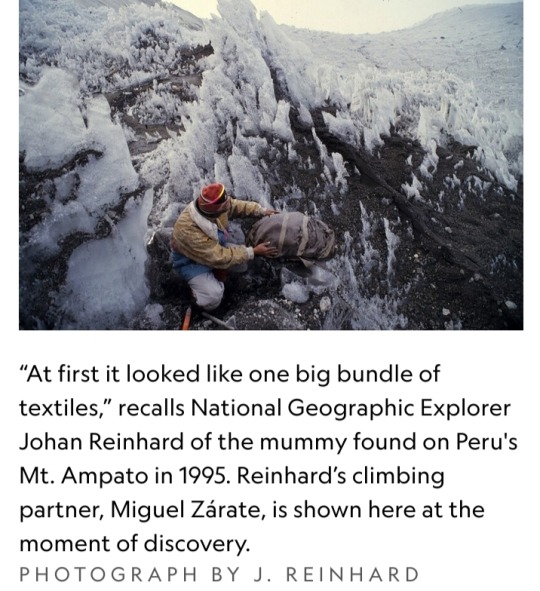
A sacrificial offering
When National Geographic Explorer Johan Reinhard encountered the mummy, also known as Juanita, atop 21,000-foot Mount Ampato during a 1995 expedition, he knew he had discovered something spectacular.
“At first it looked like one big bundle of textiles,” Reinhard recalls. Then he saw the wizened face amid the folds of fabric.
Here was a young victim of the elusive Inca ritual known as capacocha.
Capacocha mostly involved the sacrifice of children and animals who were offered to the gods in response to natural disasters — to consolidate state power in far-flung provinces of the Inca Empire, or simply to please the deities.
The ritual played an important part in sustaining the Inca Empire. It would involve feasts and grand processions to accompany the children, who appear to have been chosen for their beauty and physical perfection.
Being selected for sacrifice, researchers believe, would have considered a deep honor by the child’s family and community.
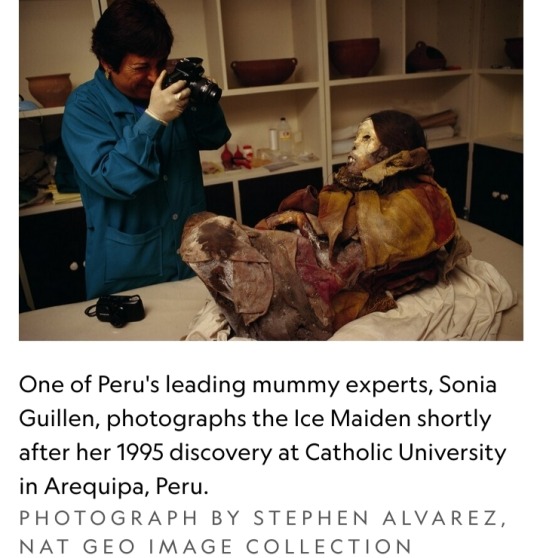
Most of the information we have on capacocha, however, is second hand, notes Dagmara Socha, an archaeologist with the Center for Andean Studies at the University of Warsaw who studies the ritual and commissioned the facial reconstruction of the Ice Maiden of Ampato.
“No European colonist ever saw the ceremony,” she explains.
Despite gaps in the historical record, the high-altitude archaeological finds of more than a dozen Inca children on Ampato and other mountains point provide critical evidence for what happened during these rituals.
The means of sacrifice varied, perhaps due to customs related to specific gods. Some children were buried alive or strangled; others had their hearts removed.
The Ice Maiden’s life ended with a single blunt-force blow to the back of the skull.
In search of the Ice Maiden
Oscar Nilsson knows that skull intimately: He spent months with a replica of it in his Stockholm studio, eventually fashioning a sculpture of the 14-old-girl that, glimpsed from afar, almost seems alive.
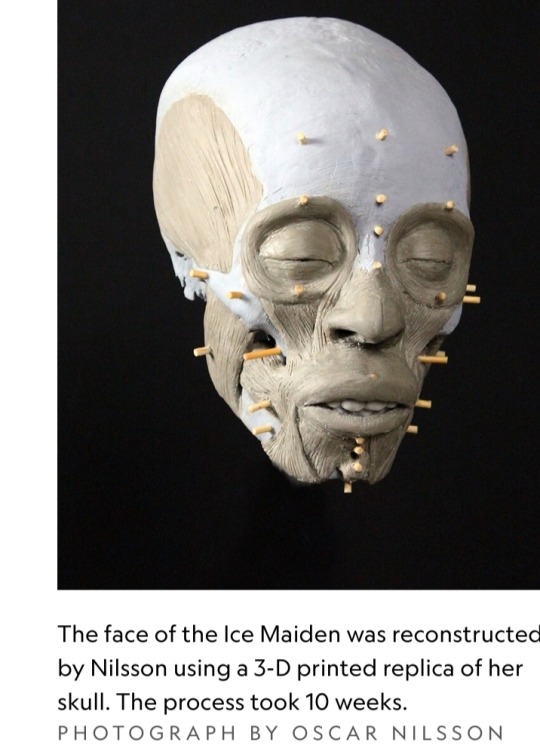
It’s a two-step process, says the Swedish archaeologist and sculptor.
First, Nilsson immerses himself in the world of his subject with an archaeologist’s eye for detail, digesting as much data as possible to understand what she might have looked like.
Even without a mummified face, he can extrapolate the likely depth of the facial tissue that once draped over those bones, using everything from CT scans to DNA analyses to information about diet and disease to make educated guesses about the individual’s face.
Then came the handiwork. Nilsson printed a 3-D replica of the Ice Maiden’s skull, plugging wooden pegs into its surface to guide the depth and placement of each hand-crafted, plasticine clay muscle.
Eerie eyes, masseter muscles, a nose, the delicate rope-like tissues that constitute a human face: each was added in turn.
After making a silicone mold of the bust, he added hundreds of individual hairs and pores in shades of brown and pink.
It took ten weeks.
Following the Inca Gods
The result, wrapped in robes woven by local women from Peru's Centro de Textiles Tradicionales, is the main attraction at “Capacocha: Following the Inca Gods” at the Museo Santuarios Andinos in Arequipa, Peru through November 18.
The reconstruction will be displayed alongside the Ice Maiden’s mummy, accompanied by the stories of 15 other children selected for capacocha atop Ampato and other Andean peaks.
Their ages range from 3 to about 13. The mummies and skeletal remains of several are featured as 3-D models at the exhibition, which also showcases holographs of some of the sacred items buried alongside them.
These natural mummies offer scientists tantalizing clues about their last days.
When Socha and colleagues conducted toxicological and forensic analyses of the remains of a toddler and four six-to-seven-year-old victims featured in the exhibition, they found they were well cared for in the months before their sacrifice.
They were fed a steady diet of coca leaves, ayahuasca vine, and alcohol in the weeks before their deaths — not as much to intoxicate them as to keep them sedated and anxiety-free as the timeline hurtled toward their sacrifice.
“We were really surprised by the toxicology results,” says Socha.
“It wasn’t only a brutal sacrifice. The Inca also wanted the children to be in a good mood. It was important to them that they go happily to the gods.”
High altitude, psychogenic substances, the spectacular view, the knowledge the afterlife was near — all must have made for an astonishing ceremony, says Reinhard.
“The whole phenomenon must have been overpowering.”
During the last phase of his reconstruction, Nilsson spent hours contemplating and attempting to capture the young girl’s presence 500 years after her death.
The result is both unsettlingly realistic and jarringly personal.
“She was an individual,” the forensic reconstructionist says.
“She must have understood her life would end on the mountaintop in a couple of weeks. We can only hope that she believed in the afterworld herself.”
For Reinhard, finally seeing the face of the girl he carried down the mountain on his back decades ago brought the Ice Maiden’s story full circle.
“It brings her back to life,” he says. The reconstruction brings the focus as much to her culture and daily life as to her spectacular death.
But Nilsson never forgot the way the Ice Maiden died, even as he brought her to life through his reconstruction.
More than anything, he says, he wanted to capture a sense of being frozen — a nod not just to her icy, mummified future but to a girl teetering on the edge of eternity, though still very much alive.
“She knew she was supposed to smile, to express pride,” he says. “Proud to be chosen. But still very, very afraid.”
#Ice Maiden of Ampato#Inca Girl#archaeological analysis#forensic reconstruction#human sacrifice#Peru#3-D bust#Juanita#Johan Reinhard#Mount Ampato#National Geographic#National Geographic Explorer#expedition#1990s#20th century#capacocha#Inca ritual#Inca Empire#Dagmara Socha#facial reconstruction#archaeology#archaeologists#Oscar Nilsson#sculptor#Centro de Textiles Tradicionales#Capacocha: Following the Inca Gods#Museo Santuarios Andinos#natural mummies#culture#forensic reconstructionist
2 notes
·
View notes